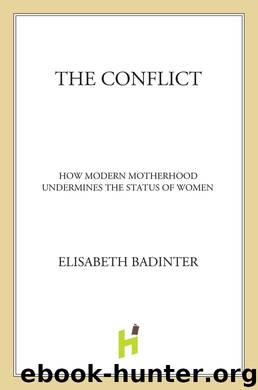The Conflict by Elisabeth Badinter

Author:Elisabeth Badinter
Language: eng
Format: epub
Publisher: Henry Holt and Co.
Published: 2012-03-11T16:00:00+00:00
Another Look at the Swedish Model
No one doubts that Sweden has made considerable efforts to reconcile motherhood with a career and create conditions for equality in the workplace. On top of the parental leave that absorbs 40 percent of the country’s family policies budget, flexible working hours for both parents of children under eight,26 and time off to care for sick children, Sweden also offers state day care.27 In sum, the Swedish model is in the vanguard of European family policies.
With what results?
As we have seen, fathers take only one-fifth of the parental leave available. As for mothers, 80 percent return to work, but two in five opt for part-time jobs.28 When Catherine Hakim published Key Issues in Women’s Work 29 in 1996, she revealed that Swedish family policies were not as conducive to sexual equality as was previously believed. They were favorable to raising the birthrate but considerably less so to advancing women’s careers. Studying all the usual criteria for measuring equality in the workplace, Hakim showed that Sweden was barely faring any better than England or France.
Looking at salaries, Hakim cites findings that 80 percent of Swedish women are paid below a given threshold, while 80 percent of men were paid above it. One reason for the divide was that two-thirds of Swedish women worked in the public sector, while 75 percent of men worked in the more difficult and demanding private sector. According to Hakim, the more the state extended its family policies, the less inclined private companies were to hire women because, they claimed, they could not afford such generous maternity leave. On top of this, the glass ceiling was no less cruel in Sweden than elsewhere. Hakim’s data showed that women comprised only 1.5 percent of top management at a time when that figure was at 11 percent in the United States. However by 2010, that figure, measured by the number of women in executive committees, had reached 14 percent in the United States and 17 percent in Sweden.30
As for the salary gap between men and women (the ultimate criterion for sexual equality), Hakim highlighted the fact that in countries with less generous family policies, the salary gap tended to be smaller. This remains true: in 2009, Swedish women across the board were paid around 16 percent less than Swedish men, comparable to France and Spain.31 In the same year, the pay gap in Australia was around 17 percent. 32 In Italy, by contrast, the gap in 2009 was only 5.5 percent; in Belgium 9, and in Poland 10 percent. (Hakim omits to point out that the birthrate has dropped dramatically in Italy.)
To date, no family policy has proved truly effective at improving equality between men and women. The division of work between a couple is still unequal in every country, including Scandinavia. The increasingly onerous responsibilities placed on mothers just aggravate the situation. Only fully sharing parental roles from birth could counter this trend, yet in the name of our children’s well-being we are taking the opposite route.
Download
This site does not store any files on its server. We only index and link to content provided by other sites. Please contact the content providers to delete copyright contents if any and email us, we'll remove relevant links or contents immediately.
Nudge - Improving Decisions about Health, Wealth, and Happiness by Thaler Sunstein(7622)
iGen by Jean M. Twenge(5368)
The Fire Next Time by James Baldwin(5253)
Adulting by Kelly Williams Brown(4489)
The Hacking of the American Mind by Robert H. Lustig(4319)
The Sports Rules Book by Human Kinetics(4302)
The Ethical Slut by Janet W. Hardy(4178)
Captivate by Vanessa Van Edwards(3796)
Mummy Knew by Lisa James(3637)
In a Sunburned Country by Bill Bryson(3486)
The Worm at the Core by Sheldon Solomon(3437)
Ants Among Elephants by Sujatha Gidla(3417)
The 48 laws of power by Robert Greene & Joost Elffers(3032)
Suicide: A Study in Sociology by Emile Durkheim(2975)
The Slow Fix: Solve Problems, Work Smarter, and Live Better In a World Addicted to Speed by Carl Honore(2950)
Humans of New York by Brandon Stanton(2835)
The Tipping Point by Malcolm Gladwell(2829)
Handbook of Forensic Sociology and Psychology by Stephen J. Morewitz & Mark L. Goldstein(2660)
The Happy Hooker by Xaviera Hollander(2656)
